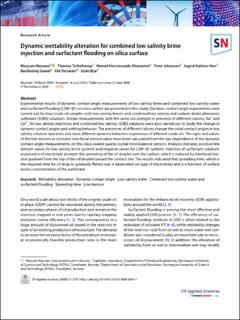| dc.contributor.author | Nourani, Meysam | |
| dc.contributor.author | Tichelkamp, Thomas | |
| dc.contributor.author | Hosseinzade Khanamiri, Hamid | |
| dc.contributor.author | Johansen, Trine | |
| dc.contributor.author | Hov, Ingrid Karlsen | |
| dc.contributor.author | Gawel, Bartlomiej | |
| dc.contributor.author | Torsæter, Ole | |
| dc.contributor.author | Øye, Gisle | |
| dc.date.accessioned | 2022-05-10T11:32:28Z | |
| dc.date.available | 2022-05-10T11:32:28Z | |
| dc.date.created | 2020-06-30T21:22:24Z | |
| dc.date.issued | 2020 | |
| dc.identifier.citation | SN Applied Sciences. 2020, 2 . | en_US |
| dc.identifier.issn | 2523-3963 | |
| dc.identifier.uri | https://hdl.handle.net/11250/2995053 | |
| dc.description.abstract | Experimental results of dynamic contact angle measurements of low salinity brine and combined low salinity water and surfactant flooding (LSW–SF) on silica surface are presented in this study. Dynamic contact angle experiments were carried out for four crude oil samples with low salinity brines and combined low salinity and sodium dodecylbenzene sulfonate (SDBS) solutions. Similar measurements with the same ion strength in presence of different cations, Na+ and Ca2+, for low salinity injections and combined low salinity–SDBS solutions were also carried out to study the change in dynamic contact angles and wetting behavior. The presences of different cations change the initial contact angles in low salinity solution injections and show different dynamic behaviors in presence of different crude oils. The signs and values of the line tension to oil/water interfacial tension ratios have been calculated from the size dependence of the dynamic contact angle measurements on the silica coated quartz crystal microbalance sensors. Analysis indicates positive line tension values for low salinity brine systems and negative values for LSW–SF systems. Injection of surfactant solutions in presence of electrolyte prompts the spreading of the oil droplet over the surface, which is induced by interfacial tension gradient from the top of the oil droplet toward the contact line. The results indicated that spreading time, which is the required time for oil drop to gradually flatten out, is dependent on type of electrolytes and is a function of surface excess concentration of the surfactant. | en_US |
| dc.language.iso | eng | en_US |
| dc.publisher | Springer | en_US |
| dc.rights | Navngivelse 4.0 Internasjonal | * |
| dc.rights.uri | http://creativecommons.org/licenses/by/4.0/deed.no | * |
| dc.title | Dynamic wettability alteration for combined low salinity brine injection and surfactant flooding on silica surface | en_US |
| dc.title.alternative | Dynamic wettability alteration for combined low salinity brine injection and surfactant flooding on silica surface | en_US |
| dc.type | Peer reviewed | en_US |
| dc.type | Journal article | en_US |
| dc.description.version | publishedVersion | en_US |
| dc.source.pagenumber | 13 | en_US |
| dc.source.volume | 2 | en_US |
| dc.source.journal | SN Applied Sciences | en_US |
| dc.identifier.doi | 10.1007/s42452-020-3094-4 | |
| dc.identifier.cristin | 1817995 | |
| dc.relation.project | Norges forskningsråd: 262644 | en_US |
| cristin.ispublished | true | |
| cristin.fulltext | original | |
| cristin.qualitycode | 1 | |

